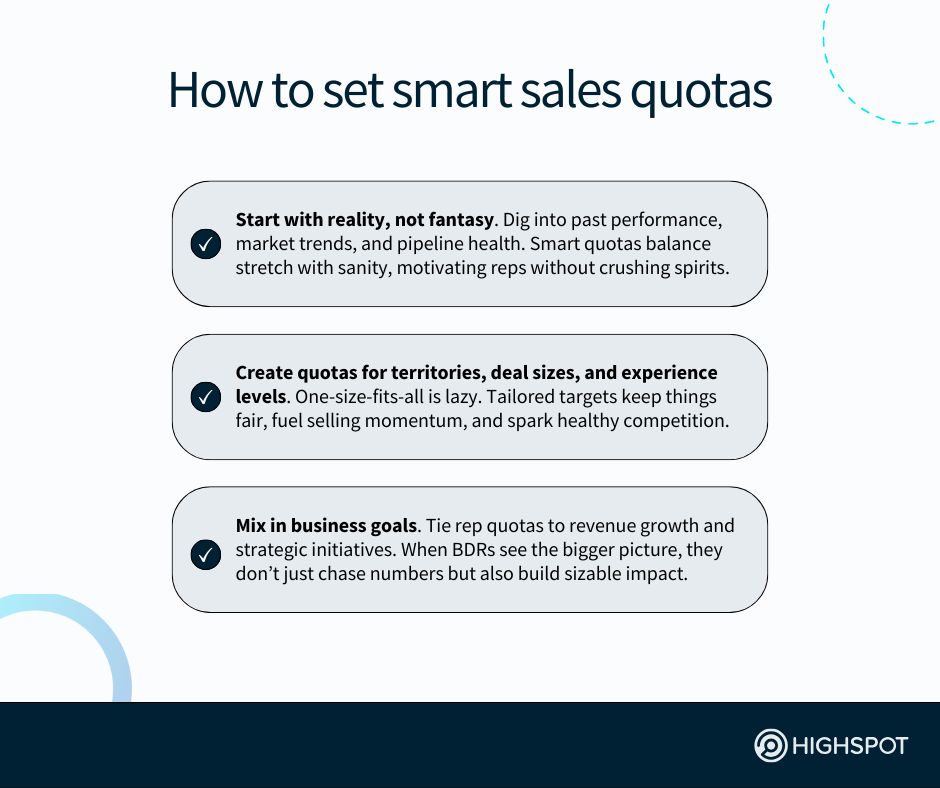Key Takeaways
- Sales quotas are the fuel behind commissions, promotions, and predictable growth. When sellers are empowered to hit them, your whole go-to-market (GTM) engine roars, leading to outsized business expansion.
- Quota-crushing isn’t magic—it’s enablement. Equipping your reps with sharp messaging, fresh insights, and AI-powered coaching and training is how your team starts hitting sales targets on repeat regularly.
- There’s more than one way to slice a sales quota. In fact, there are five distinct types of sales quotas that help managers and revenue operations leaders gauge reps’ level of productivity and efficiency over time.
Sales quota attainment is approached from different perspectives at your company:
- For sales reps, it’s the difference between earning a commission and falling short.
- For sales managers, it’s a means to motivate sellers to strengthen sales productivity.
- For sales leaders, it establishes benchmarks to track and improve sales performance.
- For sales ops, it’s a barometer for how the sales tech stack helps (or hinders) sellers.
- For revenue operations, it’s a proven way to better forecast sales in the long run.
Simply put, a lot of your organisation’s success rides on whether selling quotas are met by inside and outside reps. But, it’s vital to remember: You need to set ambitious yet appropriate quotas based on historical data—not gut instinct or simply because your leadership team has set lofty revenue-growth goals.
Too often, sales teams inherit targets that don’t reflect the market; their products, services, and business model, or the actual day-to-day selling challenges. With this, quota-setting frustration builds, and results slip.
That raises the question: How can you and other GTM leaders charged with meeting critical business objectives tied to revenue design sales quotas that challenge reps to up their games without setting them up to fail?

What is a sales quota?
A sales quota is a specific target set by leadership that individual sales reps are expected to hit within a given period—usually, on a monthly and quarterly basis.
Quotas are measured in deals closed, units sold, and/or revenue generated.
Sales quotas act as performance benchmarks that align sales efforts with broader business goals, guiding sellers through a structured, repeatable sales process.
What makes sales quotas important is how they’re ultimately tied to profit-quota and revenue-quota goals for a business. Through consistent quota attainment, reps directly contribute to their companies’ growth and forecast growth.
Effective quota-setting relies on historical data, external market trends, and the direction of the business strategy and product roadmap to estimate what’s realistic, what’s aspirational, and what will drive performance in the future.
For reps, hitting quota isn’t just about achieving their sales commissions. It’s how they advance their careers, earn promotions, and build swagger that gets noticed.
Miss the mark, and it stings. Nail it, and the bottom-line impact echoes throughout the organisation and into the C-suite—and, suddenly, top-performing reps who meet or exceed quotas become the blueprint for killer sales efforts done right.
Sales quota attainment’s impact on GTM
Sales quota attainment reflects the health of the entire go-to-market strategy.
When reps meet their sales targets assigned to them by managers, it means:
- GTM campaigns, launches, and plays are landing with B2B buyers
- Sales training is educating BDRs on how to sell smarter and savvier
- The product is adding value to potential and existing customers
Success at the rep level shows your GTM engine can scale and repeat its wins.
But the opposite is also true.
Missed sales quotas point to bigger problems. A misguided pricing model, a weak sales enablement approach, products or services that don’t solve prospects’ problems, or ineffective training and coaching are common culprits.
By setting sales quotas that are achievable, based on historical data and revenue targets, you create a positive ripple effect across your go-to-market functions:
- Your sales team’s focus sharpens and accountability increases. A clear number leaves no room for confusion. Reps can better prioritise their daily work, while sales managers can more capably guide sellers’ performance.
- Each sales representative sees a realistic path to career growth: Quotas align sales efforts to results. Hitting them leads to bonuses, promotions, and career advancement. For many sellers, quotas are stepping stones.
- The marketing and enablement teams can optimise their efforts. It’s not only on your BDRs to close deals. These other two GTM units must also pull their weight by analysing how sales content is leveraged by reps when engaging leads and what collateral influences revenue so they can double down on creating those types of assets.
- RevOps can better predict closed-won and revenue acceleration. Sales quotas give revenue and sales leaders historical data they can trust. Forecasts become more accurate, revenue patterns stand out, and—with the right GTM enablement platform—they can get AI-powered, actionable insights that can inform sales strategy adjustments.
Salesforce research from 2025 found two-thirds (67%) of reps said they didn’t meet quota by year’s end. That percentage indicates a likely lack of cohesion and collaboration among the go-to-market teams at those reps’ businesses.
With a concerted, collective effort to empower each sales organisation member to meet their numbers, your GTM teams can help unlock the potential of their reps.
5 types of sales quotas to set for reps
Sales rep quotas come in a variety of ‘flavours.’ Some popular ones include:
1. Profit quota
Profit quotas measure earnings after costs. They show how much value stayed with the company once discounts, delivery, advertising costs, or service expenses are covered. For example, a rep might be asked to generate $100,000 in net profit from new contracts, enticing them to target high-value accounts.
This approach is unpopular because reps don’t control costs, so many factors are outside of their control. These work best for companies that want to protect margins, but give reps control over discounting in negotiations.
2. Activity quota
Activity quotas track sales activities completed, such as calls, demos, and meetings booked. Instead of waiting for closed deals, they encourage consistent engagement that builds sales pipeline. For instance, a rep may need to conduct 20 discovery calls and 10 product demos every month at minimum.
This type of sales quota may build the pipeline, but it can backfire if sales reps just go through the motions to hit a number. It works well when paired with outcome-based sales performance metrics, especially when teams are introducing an entirely new product or trying to increase their market share.
3. Volume quota
Volume quotas count units sold, products, or deals, regardless of size or profitability. Think of a SaaS company setting a goal of 100 new-user signups each month.
This ‘total sales generated’-type quote works well during product launches or when moving inventory to either clear it out (retail) or saturate the market (like subscription-based businesses building a user base) is the goal. The downside is reps aiming to achieve this sales quota often ignore deal quality.
In other words, this quota encourages short-term wins over long-term value.
4. Forecast quota
Forecast quotas tie directly to pipeline health, territory potential, and market conditions. For instance, a rep could be asked to close 80% of forecasted deals in a region.
This sales quota works when reliable, historical data and consistent sales cycles are available. Where it collapses is if market trends shift dramatically, competitors cut their pricing, or an expected product release doesn’t happen. When sales leaders don’t adjust quotas in response, seller performance tends to suffer.
Flexibility and adaptability are necessary to keep this kind of sales quota fair.
5. Combination quota
Combination quotas combine measures, such as activity and revenue, or profit and volume. For example, a BDR might need to make 12 calls in a quarter and also close $150,000 in new contracts. Because they balance effort with outcomes, they often feel fairer to sales reps than a single measure.
Still, no quota is perfect. Combination quotas require careful design to prevent conflicting sales goals. Consider when a rep is asked to maximise profit and drive high volume. They might feel pulled in opposite directions.
3 approaches to setting sales quotas
Every company will take a different approach to the quota-setting process. Company size, sales force maturity, and data reliability, and other factors must be taken into account. That said, most B2B companies use one of three methods:
| Approach to setting sales quota | How it works and when to use it |
|---|---|
| Top-down | Leadership sets a total revenue goal and divides it across sales teams and individuals. It’s efficient, keeps everyone closely aligned, and suits companies with aggressive growth targets. However, it may overlook territory realities, making single sales quotas feel out of reach. |
| Bottom-up | Reps and managers build quotas based on past performance, current pipelines, and market conditions. It starts with buy-in and is particularly effective in industries with variable deal sizes. The risk is that targets may be too conservative and not sufficiently challenge the team. |
| Hybrid | Corporate leadership sets overall revenue goals, and then managers adjust based on data, like total sales generated last quarter, and local factors. Strong territories may carry more weight, while newer ones have time to ramp up. This approach balances ambition and fairness. |
When setting quotas, just be sure that all relevant business stakeholders are involved in discussions around structure, timeline, and feasibility to avoid any crossed wires and to ensure big-picture sales objectives factor in decision-making.
How to set achievable sales rep quotas
Sales quotas can feel like a challenge—or, sometimes, like punishment.
Set them too high, and they can drain reps’ confidence and energy. Set them too low, and sellers can become complacent, leading to stagnant revenue growth.
The most effective ones push sales reps to improve while staying in reach.
Best practices to follow when setting quotas for your team include:
Knowing what your sales team can realistically deliver
Effective sales managers start with your team’s current capacity.
Don’t just count past deals. Be sure to factor in sales territory size, available resources, and the average sales cycle length. If a rep usually closes five deals a month at $6,000 each. That’s $30,000 in baseline. A 15% growth target sets the new quota at $34,500. This sets the quota without guessing.
Also, account for ramp time for recently onboarded reps. New sales hires won’t move at the same pace as seasoned sellers. Start them half quota in their first quarter while they learn. Ignore ramp time, and quotas appear more like a trap.
Factor in external conditions, including competitor data
Seasonality shifts demand. Competitors adjust pricing. Economic swings tighten budgets. Even a product update (or lack of) can throw forecasts off.
A fair quota reflects these realities.
The GTM leaders who revisit sales goals and targets when conditions change maintain credibility. Ones who don’t risk punishing reps for things no one can control.
Align quota-setting with your company’s sales strategy
Numbers should connect directly to business objectives.
If the company’s focus is on wallet share, quotas need to reward upselling and cross-selling. If the aim is to break into a new market, sales activity quotas make more sense. Expanding a product line? Volume quotas help. Moving upmarket to enterprise accounts? Combination quotas work well.
| Business goal | Sales quota approach | Why it works |
|---|---|---|
| Deepen wallet share with current clients. | Revenue or profit quotas tied to upsell/cross-sell | Rewards growth inside existing accounts (upsell, cross-sell, etc.) |
| Break into an entirely new market/space. | Activity sales quotas (calls, demos, meetings) | Builds net-new pipeline and accelerates brand awareness |
| Expand an existing product or service line. | Volume sales quotas over a specific period | Encourages steady movement of products, even if margins vary |
| Move upmarket into enterprise accounts. | Combination sales quotas (activity and revenue) | Balances relationship-building with complex deal value |
Proven tips to help sales reps hit quota
Quotas can easily overwhelm even the best sales reps. Break them down into steps to make them manageable. Sales reps who stay consistent, focus on their customers, and keep learning new skills will succeed again and again.
Break quotas into smaller milestones
‘A quarterly target of $90,000 looks heavy. Slice it down to a $30,000 monthly quota, which is about $7,500 a week. Smaller sales goals and wins give momentum. Wins feel closer, progress is easier to see, and sales reps will keep moving.
Pick sales incentives and rewards that matter
Money usually motivates, but not always. Some sales reps push for recognition, others for promotions or more flexibility in their schedule. A CaptivateIQ 2025 Report found 35% of companies lack clear sales incentive structures.
Align rewards with your sales reps’ intrinsic and extrinsic motivation.
Focus on solving problems, not chasing numbers
Chasing numbers alone can backfire. Start with the customer’s needs. Potential customers who feel understood will renew, expand, and tell others.
Michal Sever, Senior. Director at Nayax, put it simply on a recent Highspot’s Win Win podcast episode: “If a customer is happy and satisfied and we are approaching them with relevant messaging and tone of voice, they might purchase more.”
Clear roadblocks that deter rep efficiency
Admin work eats into selling time.
Forrester research found that reps spend more than two full days each week on tasks such as updating CRMs, approvals, and reporting, rather than selling. Using AI can assist by auto-logging activities, summarising call notes, automating sales content creation, and suggesting next steps based on buyer engagement.
When paired with integrations that connect tools across the tech stack, automation reduces manual work, improves sales efficiency, and gives sales reps back the hours they need to sell.
Keep learning with training and coaching
Industry trends shift, buying habits change, products update. Skills must keep pace. Traditional, one-on-one coaching sharpens existing skills while training adds new ones. Sales reps who treat learning as part of the job, grow more confident, and confidence is necessary to keep hitting quota.
Enablement tools extend the learning. AI-powered recommendations highlight what content works, suggest the right materials for each deal stage, and support coaching. Together, human coaching and AI enablement create continuous improvement that scales across the team.
Sales quota attainment FAQs, answered
Your sales planning is complex—but setting quotas for reps shouldn’t be. Here are some insights that can help ensure you set appropriate targets for your reps.
Should revenue-quota goals influence the sales quotas we set?
Yes, revenue-quota goals should guide setting quotas for the entire sales team. Without that alignment, reps may pursue activities disconnected from business objectives. Strong linkage ensures that every deal contributes directly to the company’s sales forecast.
Factoring in revenue quotas also sharpens sales performance, driving consistency across territories while preventing wasted energy on low-quality deals.
How can revenue and sales leaders set smart quotas together?
Revenue and sales leaders set smart quotas by combining data and industry knowledge with frontline insight. They design quotas for individual sales reps based on territory coverage, historical attainment, and business-growth priorities. Done right, quotas motivate reps, protect morale, and strengthen sales output.
Which tools help sales managers track rep quota attainment?
Sales managers need tools that connect activity with outcomes. Popular platforms like Highspot and Salesforce track quota attainment and align it with the sales process. These systems highlight where reps succeed, where deals stall, and how quota attainment drives broader business impact.
With visibility into each rep’s pipeline health and buyer-engagement efforts, managers can step in early, coach effectively, and help boost sales performance.
How can we avoid setting unrealistic quotas for our sales team?
Avoid setting unrealistic rep quotas by using accurate sales data, past results, and current pipeline coverage. Leaders must resist over-inflating numbers during sales planning, which can demoralise teams. Instead, they should align quotas to actual market opportunity and selling capacity.
What do achievable sales quotas look like at most companies?
Achievable quotas reflect realistic expectations for the whole sales team, often calibrated at 70–80% attainment. By balancing stretch goals with achievability, leaders ensure quotas inspire without overwhelming sellers.
How does quota-setting impact our annual sales planning?
Quota-setting is central to sales planning, as it cascades revenue goals into day-to-day execution. Quotas shape headcount requirements, hiring plans, and resource allocation. They also influence the long-term forecasting, ensuring revenue leaders model realistic outcomes for the upcoming quarters.
Well-designed rep quotas also keep the entire sales organisation aligned, while unrealistic ones skew planning and hurt GTM credibility. Done right, quota-setting becomes the anchor that keeps strategy and execution in lockstep.
Should we adjust our sales targets based on quota analytics?
Yes, quota analytics reveal if adjustments are needed to maintain fairness and accuracy. By analysing quota attainment across your sales force, go-to-market leaders see whether goals stretch too far or fall short. Adjustments help align targets with market conditions and ensure a more accurate revenue forecast.
What can sales representatives do to hit quota consistently?
Reps hit quota consistently by refining their selling approaches and focusing on controllable actions. They should prioritise high-quality opportunities, manage pipeline hygiene, and leverage a sales enablement tool, like Highspot, that offers direct access to dynamic sales content and AI-powered training.




